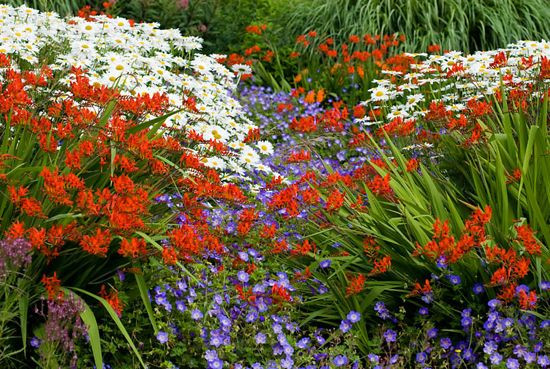Shasta Daisy
Shasta Daisy is a highly popular herbaceous perennial valued for its prominent and spectacular floral display in summer
Leucanthemum x superbum, commonly known as Shasta Daisy, is a flowering perennial plant is a hybrid produced in 1890 by the American horticulturist Luther Burbank from several daisies. It is named after California’s snowy Mount Shasta because of its large, white, snow-like flowers. Noted for its bright, cheerful flowers and resilient nature, it’s popular among gardeners worldwide.
Habit and Size: The Shasta Daisy is an upright, clump-forming perennial with sturdy stems that can withstand wind and rain, making it an excellent choice for various garden settings. Mature plants reach a height of 2-4 feet (60-120 cm) and a spread of 1-3 feet (30-90 cm), depending on the growing conditions and variety. Dwarf varieties may be smaller.
Foliage: The plant’s dark green leaves are oblong to lanceolate and coarsely toothed. They are generally clumped at the base of the plant but can also line the stems. The foliage is semi-evergreen in mild winter areas.
Flowers: The flowers are perhaps the most recognizable feature of Shasta Daisies. They typically measure 2-3 inches (5-7 cm) across, with a bright yellow center disk surrounded by white ray petals. The blooms can be single or double and have a pleasing, subtle fragrance.
Blooming Season: Shasta Daisies bloom in the summer, typically from early to late summer, depending on the variety and climate.
Hardiness: The plants are hardy in USDA zones 4-9. They can tolerate winter temperatures down to -30°F (-34.4°C).
Uses: Shasta Daisies are versatile plants often used in borders, containers, cottage gardens, and cutting gardens. They also make excellent cut flowers.
Pollinators: The bright flowers are attractive to bees, butterflies, and other beneficial insects, making them a great choice for pollinator gardens.
Toxicity: Shasta Daisies contain mild toxins that can cause vomiting, diarrhea, hypersalivation, incoordination, and dermatitis in humans and animals. According to the ASPCA, daisies are toxic to dogs and cats. It is advised to avoid consumption and handle with care.
Deer and Rabbit Resistance: Shasta Daisies are often left alone by deer and rabbits, but they may be nibbled on if food is scarce.
Drought Tolerance: Shasta Daisies have moderate drought tolerance once established, but they prefer regular watering for optimal growth and blooming.
Invasiveness: Shasta Daisies are not considered invasive.

Leucanthemum x superbum ‘Manhattan’ with Crocosmia ‘Lucifer; and Geranium ‘Rozanne’ – Courtesy of Blooms of Bressingham
Shasta Daisies are an excellent addition to many gardens due to their numerous benefits:
In conclusion, Shasta Daisies are an attractive, easy-to-care-for, versatile perennial that can bring a lot to your garden or landscaping.
| Hardiness |
4 - 9 |
|---|---|
| Heat Zones |
5 - 8 |
| Climate Zones | 1, 2, 3, 4, 5, 6, 7, 8, 9, 10, 11, 12, 13, 14, 15, 16, 17, 18, 19, 20, 21, 22, 23, 24, A1, A2, A3, H1 |
| Plant Type | Perennials |
| Genus | Leucanthemum |
| Exposure | Full Sun, Partial Sun |
| Season of Interest |
Summer (Early, Mid, Late) |
| Height |
2' - 4' (60cm - 120cm) |
| Spread |
1' - 3' (30cm - 90cm) |
| Maintenance | Low |
| Water Needs | Average |
| Soil Type | Chalk, Clay, Loam, Sand |
| Soil pH | Acid, Alkaline, Neutral |
| Soil Drainage | Moist but Well-Drained, Well-Drained |
| Characteristics | Cut Flowers, Showy |
| Tolerance | Drought, Deer, Rabbit, Dry Soil |
| Attracts | Butterflies, Bees |
| Landscaping Ideas | Beds And Borders, Patio And Containers |
| Garden Styles | Cutting Garden, Informal and Cottage, Prairie and Meadow, Traditional Garden |
Photos courtesy of 123RF Stock Photo, Growing colors, Terra Nova Nurseries, Benary and Missouri Botanical Garden
| Hardiness |
4 - 9 |
|---|---|
| Heat Zones |
5 - 8 |
| Climate Zones | 1, 2, 3, 4, 5, 6, 7, 8, 9, 10, 11, 12, 13, 14, 15, 16, 17, 18, 19, 20, 21, 22, 23, 24, A1, A2, A3, H1 |
| Plant Type | Perennials |
| Genus | Leucanthemum |
| Exposure | Full Sun, Partial Sun |
| Season of Interest |
Summer (Early, Mid, Late) |
| Height |
2' - 4' (60cm - 120cm) |
| Spread |
1' - 3' (30cm - 90cm) |
| Maintenance | Low |
| Water Needs | Average |
| Soil Type | Chalk, Clay, Loam, Sand |
| Soil pH | Acid, Alkaline, Neutral |
| Soil Drainage | Moist but Well-Drained, Well-Drained |
| Characteristics | Cut Flowers, Showy |
| Tolerance | Drought, Deer, Rabbit, Dry Soil |
| Attracts | Butterflies, Bees |
| Landscaping Ideas | Beds And Borders, Patio And Containers |
| Garden Styles | Cutting Garden, Informal and Cottage, Prairie and Meadow, Traditional Garden |
Create a membership account to save your garden designs and to view them on any device.
Becoming a contributing member of Gardenia is easy and can be done in just a few minutes. If you provide us with your name, email address and the payment of a modest $25 annual membership fee, you will become a full member, enabling you to design and save up to 25 of your garden design ideas.
Join now and start creating your dream garden!
Create a membership account to save your garden designs and to view them on any device.
Becoming a contributing member of Gardenia is easy and can be done in just a few minutes. If you provide us with your name, email address and the payment of a modest $25 annual membership fee, you will become a full member, enabling you to design and save up to 25 of your garden design ideas.
Join now and start creating your dream garden!